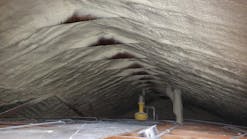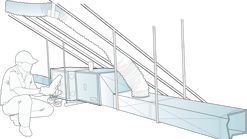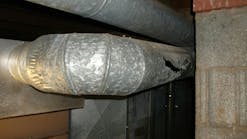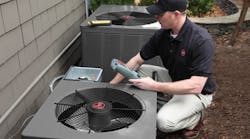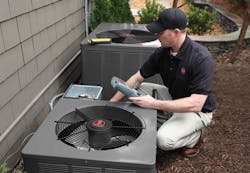Latest from Service
Handoff the Air Upgrade
Four Lessons I Learned Electrifying My Home
Prescribe an Air Upgrade Scope of Work
How to Determine Customer Air Upgrade Interest
It’s Time to Stop Saying Carbon Monoxide 'Leaks'
Quiz: Gas Furnace Venting
Four Ways We Rationalize Avoiding Combustion Testing
Springtime is not only a favorite for anyone looking forward to sunnier days, it also represents a great business opportunity for HVAC contractors.
As temperatures moderate, spring is often a “slow season” for contractors, compared to winter and summer, so offering special pre-season check-ups for residential ducted air conditioning systems can provide a steady stream of income at a time when there are fewer emergency service calls. Plus, these preventive appointments are excellent opportunities for building better relationships with current and new customers, ultimately creating more loyalty to your company.
Know What NOT To Do
To be successful at offering pre-season tune-up specials, it’s important for service technicians to know what they should and shouldn’t do. Here’s an all-too-common scenario: An untrained technician arrives at a home for a pre-season tune-up and heads straight to the outdoor condensing unit, gauges in hand. He proceeds to check the refrigerant charge. He notices that it appears to be low on refrigerant, so he adds refrigerant. He checks back with the homeowner to note that he’s completed the service call and request payment for the new refrigerant.
Here’s where trouble arises. The owner also requests the technician to change the system’s filter. When the technician removes the filter, he finds that it’s completely plugged. Now he realizes that the system didn’t need any refrigerant. What does he do? Admit he was wrong, or say nothing? If he says nothing, he’ll likely have to come back in few months to replace the compressor because the gross refrigerant overcharge will cause it to fail.
Basics of an Effective Tune-up
To effectively perform a pre-season tune-up, a technician must thoroughly check for any and all issues that may impede efficient operation or result in a system failure A typical HVAC system should be evaluated as three separate apparatuses—the indoor unit, outdoor unit, and connecting lines—working as one cohesive system.
Concerns are more often overlooked, or even ignored, on the indoor side of the system. A comprehensive pre-season tune-up should include a thorough inspection of the system’s application, installation, cleanliness of air movement/heat transfer components, and airflow.
If the pre-season tune-up is the first time a technician is visiting a customer’s home, he should closely review the complete system before performing any checks or adjustments. By asking himself the following questions, the technician can finish this initial system evaluation in just a few minutes:
• What type of system is this?
• Has the owner stated any complaints about the system?
• Where are the return air openings and air filter? Are they adequately sized, clear for airflow, and clean?
• Is the condensate drain connected, clear, and properly trapped?
• Is the supply duct in good condition? Is it adequately sized for the system?
• Is the blower or the coil dirty? If so, both must be cleaned before system operation can be checked.
• What is the refrigerant metering device? If it’s a thermostatic expansion valve (TXV), is the sensing bulb mounted properly?
• Is the indoor blower motor set up to provide the correct airflow in cfms?
Once a technician obtains this information, the outdoor unit operation should be disabled and the system enabled at the thermostat. Then, the indoor operation should be confirmed with attention focused on any abnormal sounds or visual concerns with wiring and equipment connections. If done properly, all of these steps can be executed in less than five minutes.
Navigating the Outdoor Unit
The technician should move onto evaluating the outdoor unit only after confirmation that the indoor section is functioning correctly. When he evaluates the outdoor components of the system, he should first ensure that the power is disconnected, and start with a quick visual inspection of the outdoor unit. It’s important to confirm that the coils are clean, the electrical connections are tight, and the electrical components don’t show any signs of discoloration.
Once all visual checks are completed, the technician should reconnect the power, attach his gauges, and activate the unit, paying attention to start-up sounds and pressures. The system should run for about 10 minutes or so to stabilize before any measurements are taken. The technician should pay close attention to any vibrating wires or tubes, and any frost lines on the refrigerant tubing. Frost lines can indicate restrictions and should be investigated immediately. Vibrating wires or tubes should be secured to prevent failure.
After the system is stable, the technician must check the refrigerant charge as outlined by the system manufacturer, adding or removing refrigerant as necessary. He should record the refrigerant line temperatures at the indoor and outdoor units on both the liquid and vapor lines. The liquid line temperature should be about the same at both the outdoor and indoor coils. The vapor line temperature, however, should be slightly higher the farther away it gets from the indoor coil.
It’s important to check for a temperature drop across any filter/driers, and look for the refrigerant flow arrow to confirm that they’re installed appropriately. Any drier with a temperature drop greater than 3F should be replaced.
Knowing the temperatures of the liquid and vapor lines is a lot like having “x-ray vision” into the inner workings of the unit. If these temperatures are correct, then it’s safe to assume that the mechanics of the system are in good working order.
The technician should finish the tune-up by making sure the outdoor unit stops and starts without any issues. Finally, he should ensure that all covers and wires are back in place and confirm that the system has cycled on and off one more time from the thermostat.
Ready for Cooling Season
Pre-season check-ups give homeowners peace-of-mind that their HVAC system can run smoothly throughout the summer. Contractors, in turn, benefit from an opportunity to build stronger relationships with homeowners while supplementing their business’ bottom line during the slower spring season.
The above guidelines are good starting points for most scenarios, but keep in mind that each application is different and will require its own unique maintenance schedule. Most HVAC manufacturers offer tips for performing pre-season checks specific to their equipment, so be sure to see if your distributor can provide additional information about the products your company services.
Ed Lightner serves as product support manager for Rheem’s Air Conditioning Division. He joined Rheem nearly 27 years ago and has been in his current role since 2002.
